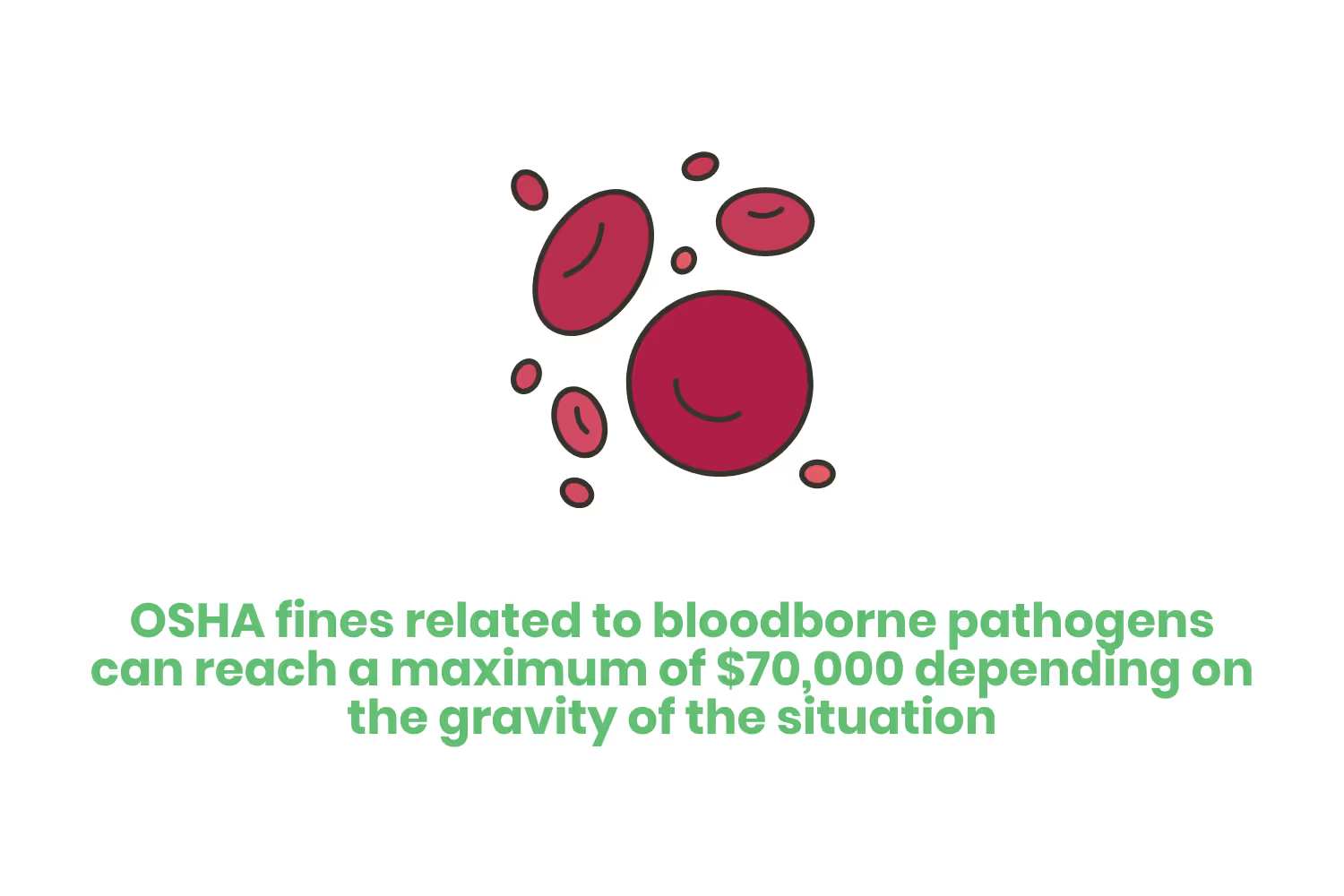40+ Workplace Bloodborne Pathogens Quiz Questions
Ensuring that all employees are aware of procedures will reduce the risk of exposure incidents. You will be able to maintain a safe workplace. And I’ve already alluded to this, but one of the most effective ways to keep your employees safe is through training. Training usually involves a test at the end. For this reason, we compiled a list of bloodborne pathogens quiz questions that will test your knowledge. So, how much do you know about workplace bloodborne pathogens?

The Occupational Safety and Health Administration, also known as OSHA, announced the implementation of the Bloodborne Pathogens Standard in December 1991. This standard’s mission is to prevent injuries and protect the health of U.S. workers.
In a nutshell, the Bloodborne Pathogens Standard imposes safety requirements on employers of workers who can become exposed to blood. Pretty overarching requirement, right? Well, employees who work in healthcare such as primary care doctors, dentists, and emergency room staff have the highest chances of exposure.
Under the standard, employers need to protect workers against health hazards. They need to adopt preventive measures such as occupational exposure control plans, hepatitis B vaccinations, and annual training for all employees.
Organizations that fail to comply with these requirements can face OSHA fines. Such fines can reach a maximum of $70,000 depending on the gravity of the situation.

The standard’s requirements also state that employees need to be regularly trained on the risks of occupational exposure to infectious materials. Workers need to have a thorough understanding of the diseases that bloodborne pathogens can transmit. They also need to know the precautions to put in place to avoid such diseases.
Ensuring that all employees are aware of procedures will reduce the risk of exposure incidents. You will be able to maintain a safe workplace. And I’ve already alluded to this, but one of the most effective ways to keep your employees safe is through training. Training usually involves a test at the end. For this reason, we compiled a list of bloodborne pathogens quiz questions that will test your knowledge.
So, how much do you know about workplace bloodborne pathogens?
Multiple Choice
Of course, the best way to kickoff our giant list of workplace bloodborne pathogens quiz questions is with the most common type; multiple choice.
After all, research shows that multiple choice questions are a learning enhancer.
In this section, we’ve curated a set of thought-provoking queries designed to evaluate your understanding of bloodborne pathogens, their transmission, prevention methods, and response protocols in case of exposure.
1. What is the definition of bloodborne pathogens?
- Infectious microorganisms infiltrate human blood or other bodily fluids. They carry diseases that people can transfer from one person to the other.
- Microorganisms in bodily fluids like tears, sweat, and saliva. They are infectious and people can transmit them by sharing toilets or computers.
- Viral infections attack the respiratory system and can cause fever, chills, and headaches.
2. Epidemiology is:
- The medical science behind tracking and controlling bloodborne diseases
- The bloodborne pathogen standard
- The signs and symptoms that will show if the employee develops a BBP infection
- A layer of skin
3. What are the three most common Bloodborne Pathogens in the United States?
- Hepatitis B, Syphilis, and Ebola
- Human Immunodeficiency Virus, Hepatitis C, and Hepatitis B
- Malaria, Zika, and Human Immunodeficiency Virus
4. John Smith last attended an OSHA bloodborne pathogen training session on June 1st of the previous year. It is now July 1st of the current year. John’s employer:
- Has met OSHA requirements for training on bloodborne pathogens
- Violates OSHA standards
- Has 11 months to retrain John or will be in violation of OSHA standards
- Has 5 months to retrain John or will be in violation of OSHA standards
5. In an employer’s exposure control plan, she/he needs to include a category called ‘exposure determination’. This category is best described by which of the following?
- Methods by which an employee decides how to ban an exposure was
- Jobs and Tasks with greater than normal risk of blood or OPIM exposure
- A mindset expected of your employer if she/he determines to avoid exposing employees
- Medical follow-up after exposure
6. Which of the following is NOT an element of a successful Exposure Control Plan?
- Providing Hepatitis B vaccination to all potentially exposed employees.
- Testing all employees for HIV to make sure they are not a danger to coworkers.
- Keeping a sharps injury log to identify departments and procedures causing injuries.
- Providing training to all workers that have occupational exposure to bloodborne pathogens.
7. Healthcare workers are the primary population required by OSHA to receive training on bloodborne pathogens, but others’ jobs require it too. Which of the following is NOT another population requiring training?
- Housekeepers become exposed to BBP as part of their job
- Emergency first responders (police, first aid as part of their job)
- Production facility staff
- Construction facility staff
8. Which is NOT a category an employer has to include in the facility-specific exposure control plan?
- Methods of compliance
- Hepatitis B vaccination
- Attendance policy
- Communication facility staff

9. How often should you update Exposure Control Plans?
- Monthly
- Twice a year
- Annually
- Only when there are new measures implemented.
10. Universal precautions include the use of personal protective equipment (PPE), such as.... (you may select more than one)
- Gloves
- Face mask
- Uniform
- Safety glasses
- Identification badge
11. Which of the following statements is true after an exposure incident to bloodborne pathogens? (more than one may apply)
- After accidental exposure to contaminated blood, a person will show symptoms in less than 5 minutes and is in danger of death. You should take exposed employees to the hospital immediately.
- Being exposed to bloodborne pathogens does not always mean infection, but you must always wash and flush all exposed areas as well as report the incident to your supervisor. Follow-up measures include a confidential medical evaluation immediately after the exposure.
- In case of an exposure incident, the employer should examine the control plan and identify the processes and procedures that led to the incident. You should make changes to the control plan as needed to prevent future exposure.
- If an exposure happens, he/she should immediately take a bloodborne pathogens test and you must share all results with the rest of the workers so they are all aware of the risks in the workplace.
12. Which of the following is an example of an exposure incident to bloodborne pathogens?
- An object that contains the blood of an infected person touches someone's skin.
- Someone's blood splashes into your eye.
- An accidental puncture with a contaminated needle stick.
- All of the above
13. What is usually the first action in the event of an exposure incident?
- Notify appropriate personnel
- Seek medical treatment
- Wash the area thoroughly
- Complete an incident or accident report
14. To reduce the risk of exposure to bloodborne pathogens, employees should:
- Attend training sessions to be able to identify risks and procedures to safely dispose of infected materials.
- Avoid being in contact with patients who have bloodborne pathogens.
- Clean their protective equipment (PPE) every day and buy a new set once a month.
- None of the Above
15. Why is the medical and reporting follow-up time frame six months in the event of an exposure incident?
- Because it takes that long for paperwork to find its way back to the employer
- To match the average time frame for HIV conversion from negative to positive
- Ti promote follow-up before an employee quits or terminated
- To allow time for the person to health form a Hepatitis B infection
16. Which is an appropriate procedure for the disposal of a used needle?
- Bend or break it to let others know that it is a used needle and potentially contaminated.
- Deposit it into a puncture-resistant sharps container.
- Put the cap back on and throw it in the trash.
- All of the above
17. The Hepatitis B virus can survive in dried blood for up to:
- Four days
- 3 hours
- Up to one week
- One month
18. Hepatitis B vaccination protects for:
- Six months
- Two years
- Ten years
- Life
19. What must your employer offer for free if you are at occupational risk of exposure to bloodborne pathogens? (Select all that apply)
- Hepatitis C vaccination
- Personal protective equipment
- First aid kit
- Medical evaluations in case of exposure
- Hepatitis B vaccination
20. Regarding the Hepatitis B vaccine, the employer…
- Can only charge the employee the cost of the vaccine, not the cost of employee time to prepare and administer the vaccine
- Has an obligation to provide the employee with a copy of his/her vaccination record
- Must provide the vaccine within ten days to new employees at risk of exposure to blood/OPIM
- Can give the vaccine orally
21. Waste bags or containers for biological hazardous materials should be of which color?
- Blue
- Black
- Red
- Clear
22. You cannot store biological waste in healthcare settings accessed by the public longer than ________.
- Four hours
- 24 hours
- One week
- Thirty days
True or False
What’s a comprehensive bloodborne pathogens quiz without a few true or false questions as well?
True and false questions are the number one most approachable type of question to provide on a quiz.
With our true or false questions, you'll have the opportunity to evaluate your knowledge about the modes of transmission, symptoms and identification, proper prevention methods, and the correct response protocols in case of potential exposure. So, get ready to assess your understanding of workplace safety and bloodborne pathogen awareness by tackling these true or false statements.
Are you ready to separate fact from fiction? Let's dive in!
1. There is currently no vaccination available for Hepatitis.
- True
- False
2. Blood is the only bodily fluid that can carry pathogens.
- True
- False
3. It is important to understand and follow your employer’s policies regarding bloodborne pathogens.
- True
- False
4. The relative risk of exposure to bloodborne pathogens is great. However, once exposed the diseases are not that serious.
- True
- False
5. Personal protective equipment is an important line of defense against exposure to bloodborne pathogens.
- True
- False
6. Universal Precautions mean treating bodily fluids as if you know they are infectious.
- True
- False

7. There are only 3 bloodborne diseases.
- True
- False
8. You can reuse disposable PPE if it is properly decontaminated.
- True
- False
9. All persons infected with a bloodborne pathogen will begin showing symptoms soon after infection.
- True
- False
10. You should select PPE based on the types of exposure that are reasonably anticipated.
- True
- False
11. It is the responsibility of the employees to provide PPE for themselves.
- True
- False
12. Hand washing is an important part of disease prevention.
- True
- False
13. You should place contaminated waste immediately in the nearest waste basket.
- True
- False
14. You should only complete an incident report if you do not know whose blood you were the source of the exposure.
- True
- False
15. The Needlestick Safety and Prevention Act requires the use of safer needles and disposal containers.
- True
- False
16. Personal protective equipment (PPE) will protect employees from all exposure incidents.
- True
- False
17. Using universal precautions means that you should treat all human blood, bodily fluids, and other potentially infectious material as if you know it’s infected by bloodborne pathogens.
- True
- False
18. If you are wearing gloves, there is no need to wash your hands after cleaning up blood or other bodily fluids.
- True
- False
19. The person to notify in the event of an exposure incident is always the direct supervisor.
- True
- False
Conclusion
Complying with the OSHA Bloodborne Pathogens Standard protects employers like yours from lawsuits. This also protects employees and patients from injury and exposure to disease.
Knowing how to protect yourself and prevent exposure to bloodborne pathogens can make a difference in your community. Yet all the equipment and information will do you no good if you’re not taking annual training.
If you found it difficult to take the workplace bloodborne pathogens quiz above, you may want to consider taking new training. Etactics can help you with this!
Emphasize your product's unique features or benefits to differentiate it from competitors
In nec dictum adipiscing pharetra enim etiam scelerisque dolor purus ipsum egestas cursus vulputate arcu egestas ut eu sed mollis consectetur mattis pharetra curabitur et maecenas in mattis fames consectetur ipsum quis risus mauris aliquam ornare nisl purus at ipsum nulla accumsan consectetur vestibulum suspendisse aliquam condimentum scelerisque lacinia pellentesque vestibulum condimentum turpis ligula pharetra dictum sapien facilisis sapien at sagittis et cursus congue.
- Pharetra curabitur et maecenas in mattis fames consectetur ipsum quis risus.
- Justo urna nisi auctor consequat consectetur dolor lectus blandit.
- Eget egestas volutpat lacinia vestibulum vitae mattis hendrerit.
- Ornare elit odio tellus orci bibendum dictum id sem congue enim amet diam.
Incorporate statistics or specific numbers to highlight the effectiveness or popularity of your offering
Convallis pellentesque ullamcorper sapien sed tristique fermentum proin amet quam tincidunt feugiat vitae neque quisque odio ut pellentesque ac mauris eget lectus. Pretium arcu turpis lacus sapien sit at eu sapien duis magna nunc nibh nam non ut nibh ultrices ultrices elementum egestas enim nisl sed cursus pellentesque sit dignissim enim euismod sit et convallis sed pelis viverra quam at nisl sit pharetra enim nisl nec vestibulum posuere in volutpat sed blandit neque risus.

Use time-sensitive language to encourage immediate action, such as "Limited Time Offer
Feugiat vitae neque quisque odio ut pellentesque ac mauris eget lectus. Pretium arcu turpis lacus sapien sit at eu sapien duis magna nunc nibh nam non ut nibh ultrices ultrices elementum egestas enim nisl sed cursus pellentesque sit dignissim enim euismod sit et convallis sed pelis viverra quam at nisl sit pharetra enim nisl nec vestibulum posuere in volutpat sed blandit neque risus.
- Pharetra curabitur et maecenas in mattis fames consectetur ipsum quis risus.
- Justo urna nisi auctor consequat consectetur dolor lectus blandit.
- Eget egestas volutpat lacinia vestibulum vitae mattis hendrerit.
- Ornare elit odio tellus orci bibendum dictum id sem congue enim amet diam.
Address customer pain points directly by showing how your product solves their problems
Feugiat vitae neque quisque odio ut pellentesque ac mauris eget lectus. Pretium arcu turpis lacus sapien sit at eu sapien duis magna nunc nibh nam non ut nibh ultrices ultrices elementum egestas enim nisl sed cursus pellentesque sit dignissim enim euismod sit et convallis sed pelis viverra quam at nisl sit pharetra enim nisl nec vestibulum posuere in volutpat sed blandit neque risus.
Vel etiam vel amet aenean eget in habitasse nunc duis tellus sem turpis risus aliquam ac volutpat tellus eu faucibus ullamcorper.
Tailor titles to your ideal customer segment using phrases like "Designed for Busy Professionals
Sed pretium id nibh id sit felis vitae volutpat volutpat adipiscing at sodales neque lectus mi phasellus commodo at elit suspendisse ornare faucibus lectus purus viverra in nec aliquet commodo et sed sed nisi tempor mi pellentesque arcu viverra pretium duis enim vulputate dignissim etiam ultrices vitae neque urna proin nibh diam turpis augue lacus.




